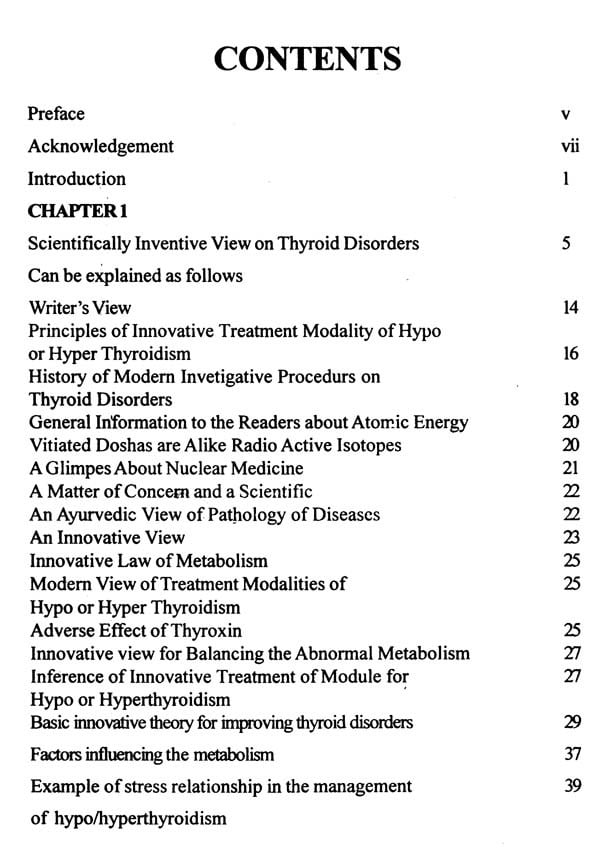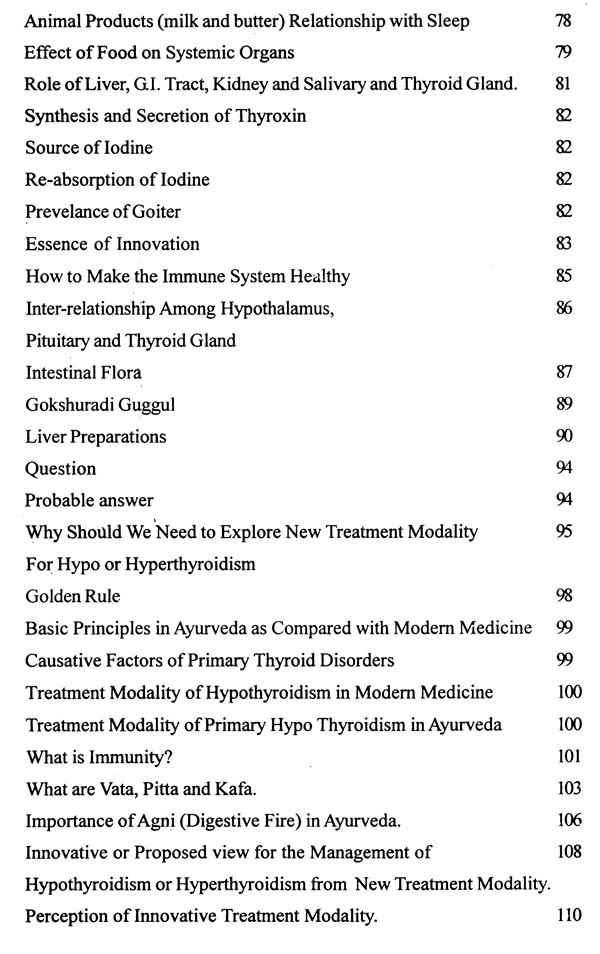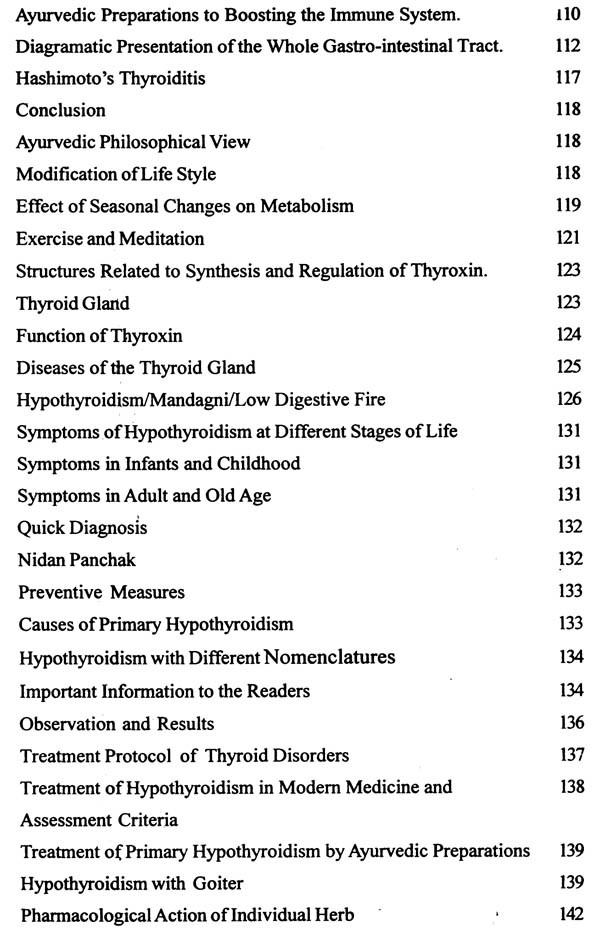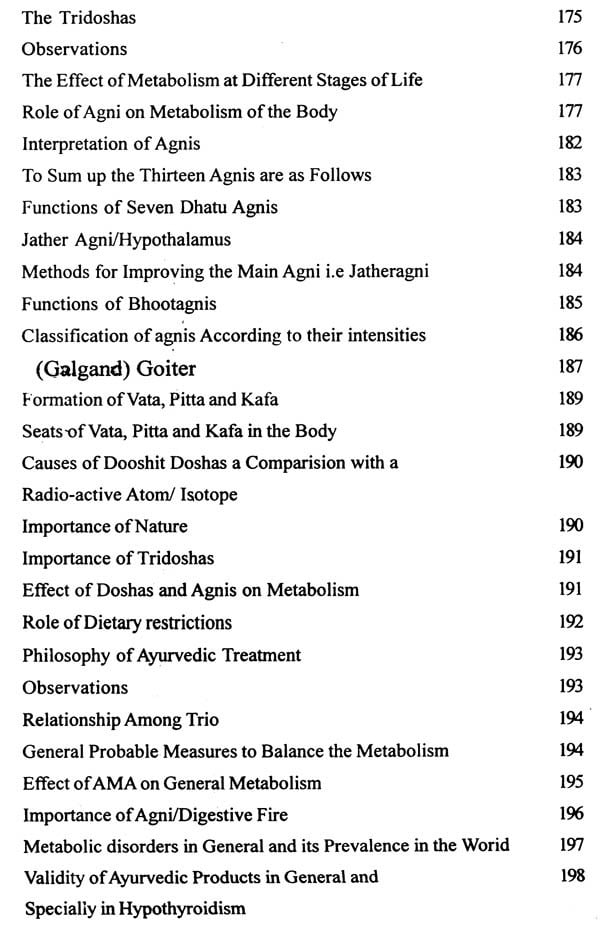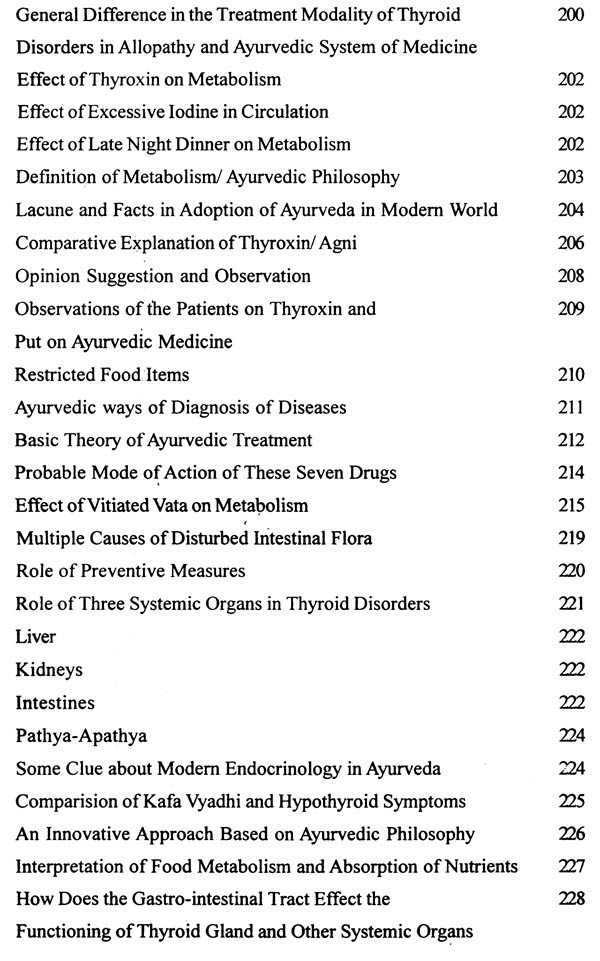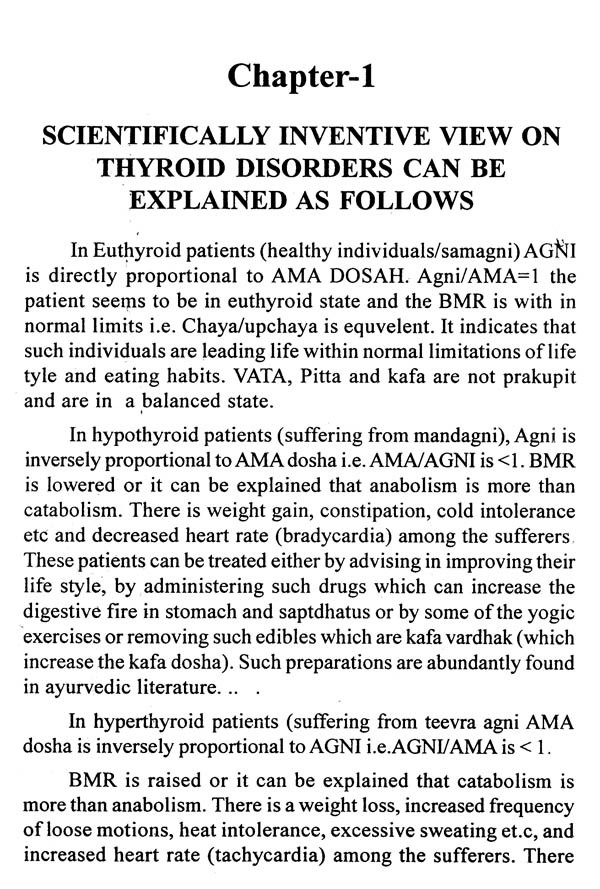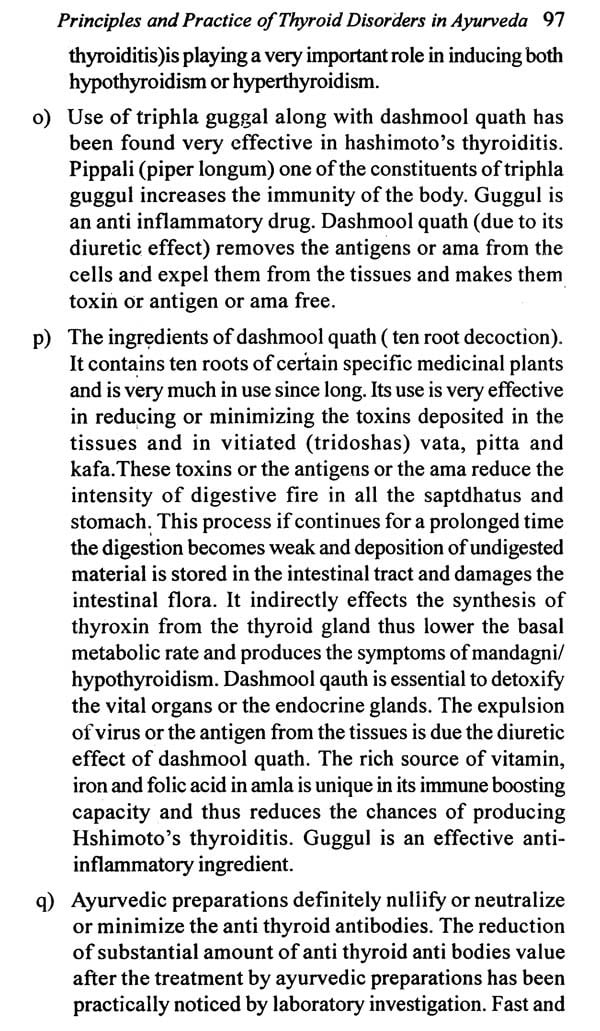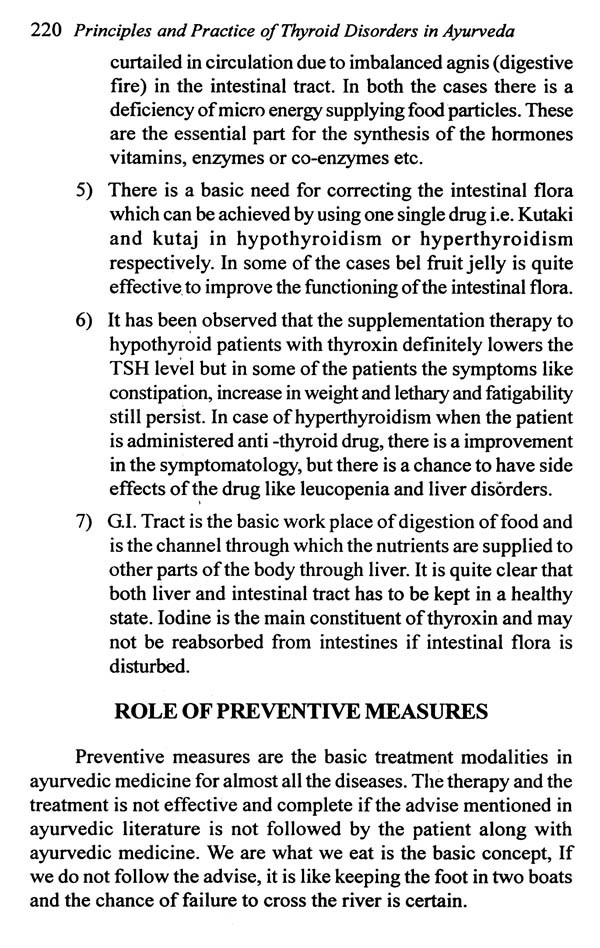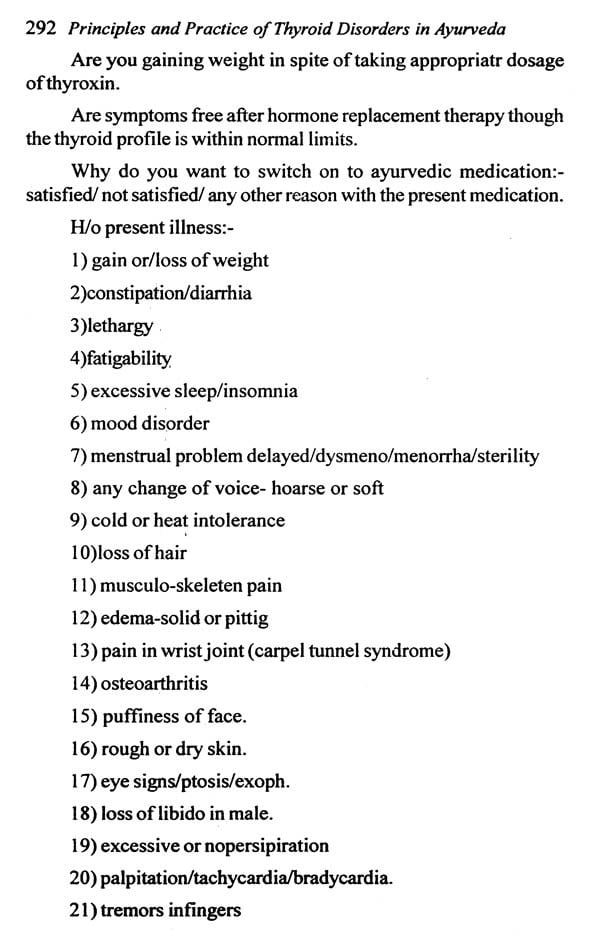
Principles and Practice of Thyroid Disorders in Ayurveda (An Innovative Treatment Modality)
Book Specification
| Item Code: | NAF616 |
| Author: | Dr. D. V. Gupta |
| Publisher: | CHAUKHAMBHA ORIENTALIA, Delhi |
| Language: | English |
| Edition: | 2013 |
| ISBN: | 978189469597 |
| Pages: | 136 |
| Cover: | Hardcover |
| Other Details | 8.5 Inch X 5.5 Inch |
| Weight | 340 gm |
Book Description
BIMS degree holder from A&S Tibbia College, New Delhi (Delhi University. Delhi) in 1966. Studied at Banaras Hindu University (BHU) for post graduation in ayurveda in 1969, did Ph.D in Kaya chikita (with special reference to Primary hypothyroidism in ayurveda) from Tilak Ayurveda Maha Vidyalaya, Pune University, Pune in 2009. has vast experience in dealing with thyroid patients. worked as senior Scientific Assistant in the Institute of Nuclear medicine and allied science (INMAS) (a unit of DRDO, a prime institute of thyroidology in India) and was closely associated in research studies in thyroid disorders with the director late Brig. S.K. Mazumdar, (father of unclear medicine in India). Resigned in 1974 after gaining a sufficient experience in diagnostic modern teachnology and treatment methodology in various thyroid disorders. Doing research in Ayurvedic science since then to treat thyroid disorders through ayurveda. Gained a remarkable achievement to treat hypothyroidism through AYURVEDIC PHILOSOPHY only without hormone replacement therapy (thyroxine) to some extent. Scientific research work in the managment of Thyroidology in ayurveda is till continuing.
Ayurveda, “the knowledge of life sciences” is an ancient philosophy of preventive and curative treatment methodology of India. The medicinal resource from plants, herbs, shrubs, metals, non-metals and their use in different diseases are mentioned in Ayurvedic text books. The formulae which were invented and practically used by the ancient revered physicians of India are still continuing even after thousands of years. This indicates the authenticity, safety and the efficacy of the ayurvedic medicines in the management of all most all the diseases. The history related to this unique medicament is mentioned in the Charak Sahimta, Sushurut Sahimtas, Vagabhatta (Ashtang), Madhav Nidan and Bhaishajya Ratnavali. A lot of emphasis on the diagnosis of the diseases with the help of the application of tridoshaj theory and pulse examination has been laid in these books. A sufficient knowledge of metabolism of the body has also been described. The problems of thyroid disorders are mentioned but not broadly and specifically. There is a small description of galgand (goiter or ghengharog) which has been highlighted in the ayurvedic text books. The factors which unbalance the Doshasas (vata, pitta and kafa), Malas ( waste end products), Agnis ( digestive fire) and Dhatus( tissues) of the different diseases has been clearly explained in almost all the books related to ayurveda. This valuable information gives the clue of understanding the low or high metabolism and about the basal metabolic rate (BMR) of the body. Agni or the digestive fire has been taken as the key Messenger in the assessment of metabolic state of a person in this study. Excessive or dificient digestive fire (agni) in the GIT or in the dhatus and Panch Mahabhootas provides an impression of hyper or hypo metabolism of the body. Thyroid disorders like hyperthyroidism or hypothyroidism have been considered for such conditions of imbalanced metabolism (Irregularities of functions of vata, pitta, and kafa and agni). The symptoms in modern and ancients systems of medicine have been matched and compared as with the underactive or overactive stages of the thyroid gland.
A Brief description of enlargement of the thyroid gland is mentioned in the ayurvedic text books and has been named as Galgand (goiter or the enlargement of the thyroid gland). GOITRE is called as GHENGA ROG in hilly and rural areas of India. Accordingly goiter or galgand has been classified as Vataj, pittaj, medaj and tridoshaj galgands, depending upon the excessive prevalence of that particular dosha in the enlarged thyroid gland. The treatment modality is also mentioned and might be practiced by some of the Ayurvedic practitioners in the olden days, but no statistically documented data is available in any literature due to some unknown reasons or the lost books on Ayurvedic management of diseases.
After acquiring a sufficient and practical study of thyroid disorders through modem medicine and AYURVEDA, (a chapter mentioning atinindneeya purush, most disfigured person, mentioned in Charak Samhita), and conducting a comparative study of the symptoms of hypothyroid and hyperthyroid (narrated in Charak and Sushrut), with those of found in modern medicine, a conclusion has been drawn that by balancing the doshas, agnis, dhatus, malas and by maintaining the positive thoughts of the mind, the patients suffering from thyroid disorders can be brought to their euthyroid state.
A brief history of the “ORIGIN OF AYURVEDA” and “WHAT IS AYURVEDA” is mentioned here for the information of those who are not aware of the facts about it. A documentary proof of the curative rate of hypothyroid patients with ayurvedic philosophy of treatment has also been prepared and is mentioned in this book. The data of such patients have been collected. The results obtained are quite encouraging both objectively and subjectively.
The main treatment modality for treating hyperthyroidism and hypothyroidism is based on the efficacy of digestive fire (agni) present in the gastro-intestinal-tract and in the other tissues of the body. Intestinal flora which commonly becomes dysbiotic, (due to unnatural habits of life style, eating fast or junk food, abnormal drinking of alcoholic beverages, tobacco, misuse of pain killers and antibiotics etc) is unable to digest the food properly, leads to either constipation or diarrhea. The absorption of essential nutrients and other elements, required for the synthesis of endocrine hormones, digestive hormones, enzymes, essential fatty acid, amino acids, carbohydrate metabolism, vitamins and the material required for repairing of the wear and tear of the tissues of vital organs is impaired. The synthesis of thyroxin by the thyroid gland is also disturbed. Ayurvedic preparations which are quite safe and effective (to improve the functioning of the intestinal flora) are used to enhance or to reduce the intensity of digestive fire (agni) in all the seven dhatus to balance the metabolic activity in hypothyroidism and hyperthyroidism.
Triggering is required to propagate any change anywhere in this universe. The human body also needs some biochemical substances or Neuro-transmitters to provide such metabolic changes which enrich the body tissues with energy and to expel the metabolic waste from the body. This balancing process is continuously going on in the body which is controlled by the presence of required amount of thyroxine or agni (digestive fire) in circulation. It (thyroxine) is synthesized by the thyroid gland. The three Doshas ( vta, pitta and kafa) and thirteen agnis (digestive fire) present in seven Dhatus, Panch mahabhootas and Jathar (stomach) play the role of thyroxine( to my assumption). Thyroid is the most important gland which gets the command from pituitary gland and hypothalamus to synthesize a required quantity of thyroxine under normal physiological conditions.. A comparative study of both ayurvedic and allopathic medicine has been conducted to treat this metabolic disorder which arises due to the malfunction of the thyroid gland. The concept of Agnis present in each and every cell of the body (mentioned in the ayurvedic literature) has been taken as a pivot to treat these metabolic disorders.
Ayurveda, the latent ancient life science has been lying in a dormant state for the last about more than last one century. It might be due to the development of modern medical research and advanced technology. But as the time passes, some of the adverse effects of allopathic medicine has again open the door for the use of ayurvedic medicines. The miracle of treating many chronic ailments through ayurvedic treatment modality has given a ray of hope to make it a popular art of healing of ancient life science in modern world. Panch karma is a wonderful cleansing and healing process for boosting the balanced metabolism and expelling the waste from the systemic organs. Fasting and other poorva karmas have been followed to balance the vata, pitta, kafa, agni and mental status. Thus ayurvedic approach can be a leading phenomena in many other metabolic disorders too.
The book has been divided in to three parts. The first part denotes the necessity for the knowledge of modern medical sciences and methodology of the treatment of thyroid disorders. The second part deals with the special features providing some knowledge of Ayurveda, the basic principles of Vata, Pitta, and kafa, the concept of Agni/digestive fire/thyroxine in relation to metabolism has also been elaborated. The third part contains the treatment methodology of thyroid disorders, based on the basic principles and philosophy of ayurveda.
A little bit history of the origin of this ancient indigenous medical science and its application for treatment of various diseases by the honorable physicians of India who practiced it for the last bout five thousand years has also been mentioned. Its failure in modem days has also been highlighted. The book contains sufficient material under various headings to help the readers to understand the philosophy and the treatment modality of hypothyroidism through this unique ancient medical science.
The formation of vata, pitta and Kafa from Panch-Mahabhootas and their effect on the body is explained in the 2nd chapter. The knowledge about Panch-Mahabhootas and their respective agni has also been clarified. The energy which they possess in a dormant state in the substances we eat, gets ignited with the amalgamation of the respective agnis of the dhatus, not only provides energy but also enhances the metabolic activity inside the systemic organs.
Brief knowledge of thyroid gland, its functions, the relationship with hypothalamus and pituitary in modern medicine has also been mentioned in the first part of this book. Efforts have been made to simplify the Ayurvedic science in relation with the metabolism. Enlargement of Thyroid gland i.e. galgand (goiter) has been explained in ayurveda as Vataj, pittaj, kafaj and tridoshaj with respective treatment modality.
The symptoms, diagnosis (based on Ayurvedic philosophy and modem medicine) and treatment methodology of hypothyroidism with Ayurvedic and allopathic medicines has been described in their respective part. Post Partum Hypothyroidism and low Grade hypothyroidism has also been treated with the help of ancient philosophy of Ayurveda without administering thyroxine.
Book's Contents and Sample Pages
